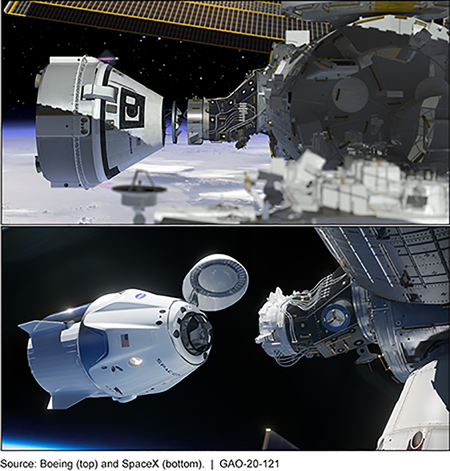NASA Commercial Crew Program: Significant Work Remains to Begin Operational Missions to the Space Station
Fast Facts
NASA contracted with Boeing and SpaceX to develop vehicles to transport astronauts to the Space Station. After years of delays, NASA will have fewer astronauts on the Space Station in 2020 unless Boeing and SpaceX are ready to fly missions. But both contractors and NASA have significant work to do to meet this goal.
In 2018 we recommended that NASA develop a back-up plan to maintain access to the Space Station if delays continued. NASA has not come up with a comprehensive plan.
In addition, we’re recommending that NASA and the FAA finalize plans related to the licenses covering launch and reentry operations that FAA must grant for each mission.
Artist depiction of contractors' crew vehicles near the International Space Station

Illustration of space vehicles above earth
Highlights
Why This Matters
Since retiring the Space Shuttle in 2011, NASA has depended on Russia to transport astronauts to the International Space Station (ISS). NASA's Commercial Crew Program is a multibillion dollar effort to re-establish a U.S. capability to get a crew to space, but it is years behind schedule. NASA may have to continue to rely on the Russian transport option or risk losing access to the ISS in 2020.
Key Takeaways
NASA will have fewer astronauts on the ISS in 2020 unless the Boeing and SpaceX spacecraft are ready to fly missions, but significant work remains for both. NASA has few back-up options if delays continue and will have only one astronaut on the U.S. side by April 2020. Most of this astronaut's time will be spent on maintenance activities rather than on research and development.
To fly as soon as possible, NASA has been planning to complete its reviews of the contractors' systems under aggressive time frames. This approach is risky because it assumes the contractors will complete multiple activities on time. Boeing and SpaceX must conduct additional test flights, train astronauts, and get a license from the Federal Aviation Administration (FAA).
FAA licenses cover the contractors' launch and reentry activities. FAA may grant waivers for changes to the license that do not jeopardize public safety. For example, FAA may grant waivers for changes in launch trajectory. NASA needs to know when such changes have been made in case they affect the crew. While NASA and FAA have coordinated on launch licensing for years, they have not yet decided how they will communicate about waivers. As a result, NASA may not have all the information it needs for launch decisions.
Artists' Depictions of Boeing (top) and SpaceX (bottom) Spacecraft Docking with the International Space Station

Recommendations
We recommended in 2018 that NASA develop a plan to maintain access to the ISS; this recommendation has yet to be implemented. In this report, we add two recommendations to improve communications on waivers between NASA and FAA. Both agencies agreed.
How GAO Did This Study
We reviewed NASA and FAA's memorandum of understanding and joint program management plan, and program and contract documents. We interviewed NASA, FAA, Boeing, and SpaceX officials to understand progress toward the mission and the extent to which NASA and FAA have coordinated.
Recommendations for Executive Action
| Agency Affected Sort descending | Recommendation | Status |
|---|---|---|
| Federal Aviation Administration | The FAA Administrator should ensure that FAA documents how NASA and FAA will communicate about any waivers granted during the licensing process for a Commercial Crew Program mission before an operational mission is conducted. (Recommendation 2) |
Closed – Implemented
FAA agreed with our recommendation. In March 2020, FAA and NASA amended their joint program management plan. The addendum documents how NASA and FAA will communicate about any waivers granted during the licensing process for Commercial Crew Program missions.
|
| National Aeronautics and Space Administration | The NASA Administrator should ensure that NASA documents how NASA and FAA will communicate about any waivers granted during the licensing process for a Commercial Crew Program mission before an operational mission is conducted. (Recommendation 1) |
Closed – Implemented
NASA agreed with our recommendation. In March 2020, NASA and FAA amended their joint program management plan. The addendum documents how NASA and FAA will communicate about any waivers granted during the licensing process for Commercial Crew Program missions.
|
